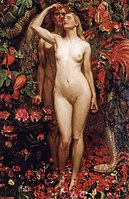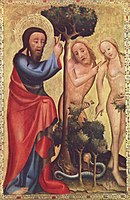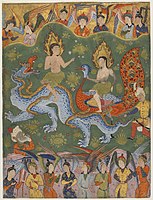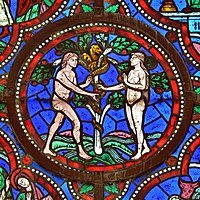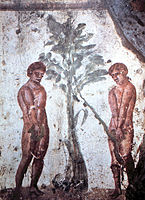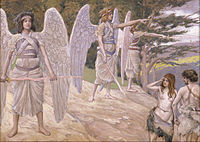ਆਦਮ ਅਤੇ ਹੱਵਾ
ਦਿੱਖ
ਆਦਮ ਅਤੇ ਹੱਵਾ, ਅਬਰਾਹਾਮੀ ਧਰਮਾਂ ਦੀ ਰਚਨਾ ਮਿੱਥ ਅਨੁਸਾਰ,[1][2][3][4][5] ਪਹਿਲੇ ਆਦਮੀ ਅਤੇ ਔਰਤ ਅਤੇ ਸਭ ਇਨਸਾਨਾਂ ਦੇ ਪੂਰਵਜ ਸਨ।[6] ਆਦਮ ਅਤੇ ਹੱਵਾ ਦੀ ਕਹਾਣੀ, ਇਸ ਵਿਸ਼ਵਾਸ ਦਾ ਧੁਰਾ ਹੈ ਕਿ ਪਰਮੇਸ਼ੁਰ ਨੇ ਮਨੁੱਖੀ ਜੀਵ ਨੂੰ ਧਰਤੀ ਉੱਤੇ ਫਿਰਦੌਸ ਵਿੱਚ ਰਹਿਣ ਲਈ ਬਣਾਇਆ, ਭਾਵੇਂ ਉਹ ਉਥੋਂ ਦੂਰ ਹੋ ਗਏ ਅਤੇ ਦੁੱਖ ਅਤੇ ਬੇਇਨਸਾਫ਼ੀ ਨਾਲ ਭਰਪੂਰ ਮੌਜੂਦਾ ਸੰਸਾਰ ਬਣ ਗਏ। ਇਹ ਇਸ ਵਿਸ਼ਵਾਸ ਨੂੰ ਆਧਾਰ ਪ੍ਰਦਾਨ ਕਰਦਾ ਹੈ ਕਿ ਮਨੁੱਖਤਾ ਮੂਲ ਤੌਰ 'ਤੇ ਇੱਕ ਹੀ ਪਰਿਵਾਰ ਹੈ, ਹਰ ਕਿਸੇ ਦੇ ਮੁਢਲੇ ਪੂਰਵਜ ਇੱਕ ਹੀ ਜੋੜਾ ਸਨ।[7] ਇਹ ਈਸਾਈ ਧਰਮ ਦੇ ਮਹੱਤਵਪੂਰਨ ਵਿਸ਼ਵਾਸਾਂ - ਆਦਮੀ ਦੀ ਗਿਰਾਵਟ ਅਤੇ ਮੂਲ ਪਾਪ ਦੀਆਂ ਧਾਰਨਾਵਾਂ ਲਈ ਧਾਰਮਿਕ ਆਧਾਰ ਪ੍ਰਦਾਨ ਕਰਦਾ ਹੈ, ਭਾਵੇਂ ਆਮ ਤੌਰ 'ਤੇ ਯਹੂਦੀ ਧਰਮ ਜਾਂ ਇਸਲਾਮ ਇਨ੍ਹਾਂ ਧਾਰਨਾਵਾਂ ਨਾਲ ਸਹਿਮਤ ਨਹੀਂ ਹਨ।[8][9]
ਜਣਨ ਦੀ ਕਿਤਾਬ ਵਿੱਚ
[ਸੋਧੋ]
ਆਦਮੀ ਦੀ ਸ੍ਰਿਸ਼ਟੀ
[ਸੋਧੋ]ਪਤਨ ਅਤੇ ਅਦਨ ਤੋਂ ਕੱਢੇ ਜਾਣਾ
[ਸੋਧੋ]
ਹੋਰ ਰਚਨਾਵਾਂ ਵਿੱਚ
[ਸੋਧੋ]ਗੈਰ ਧਾਰਮਿਕ ਵਿਚਾਰ
[ਸੋਧੋ]ਅਬਰਾਹਾਮੀ ਰਵਾਇਤਾਂ
[ਸੋਧੋ]ਯਹੂਦੀ ਧਰਮ
[ਸੋਧੋ]ਇਸਾਈਅਤ
[ਸੋਧੋ]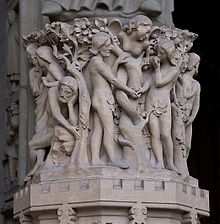
ਇਸਲਾਮ
[ਸੋਧੋ]
ਨੌਸਟਿਕਵਾਦੀ ਪਰੰਪਰਾ
[ਸੋਧੋ]ਬਹਾਈ ਧਰਮ
[ਸੋਧੋ]ਭੌਤਿਕ ਸਬੂਤ
[ਸੋਧੋ]ਵਿਗਿਆਨਕ ਅਸੰਗਤੀ
[ਸੋਧੋ]ਵਾਈ-ਕ੍ਰੋਮੋਸੋਮਿਕ ਆਦਮ ਅਤੇ ਮਾਈਟੋਕੋਂਡਰੀਅਲ ਹੱਵਾ
[ਸੋਧੋ]ਧਰਮ ਤੇ ਅਸਰ
[ਸੋਧੋ]ਕਲਾ ਅਤੇ ਸਾਹਿਤ
[ਸੋਧੋ]-
The Woman, the Man, and the Serpent by Byam Shaw
-
Adam and Eve by Titian.
-
Depiction of the Fall in Kunsthalle Hamburg, by Master Bertram
-
Adam and Eve by Albrecht Dürer
-
Eve giving Adam the forbidden fruit, by Lucas Cranach the Elder
-
Adam and Eve from a copy of the Falnama (Book of Omens) ascribed to Ja´far al-Sadiq, ca. 1550, Safavid dynasty, Iran.
-
Detail of a stained glass window (XIIth century) in Saint-Julien cathedral - Le Mans, France.
-
Adam & Eve, illuminated manuscript circa 950, Escorial Beatus
-
Adam and Eve by Maarten van Heemskerck
-
Early Christian depiction of Adam and Eve in the Catacombs of Marcellinus and Peter
-
Adam and Eve Driven From Paradise by James Tissot
-
Adam and Eve depicted in a mural in Abreha wa Atsbeha Church, Ethiopia.
ਹਵਾਲੇ
[ਸੋਧੋ]ਫੁੱਟਨੋਟ
[ਸੋਧੋ]- ↑ Womack, Mari (2005). Symbols and meaning : a concise introduction. Walnut Creek ... [et al.]: Altamira Press. p. 81. ISBN 0759103224. Retrieved 16 August 2013.
Creation myths are symbolic stories describing how the universe and its inhabitants came to be. Creation myths develop through oral traditions and therefore typically have multiple versions.
- ↑ Levenson, Jon D. (2004). "Genesis: introduction and annotations". In Berlin, Adele; Brettler, Marc Zvi (eds.). The Jewish Study Bible. Oxford University Press. ISBN 9780195297515.
{{cite book}}: Invalid|ref=harv(help) - ↑ Graves, Robert; Patai, Raphael (1986). Hebrew Myths: The Book of Genesis. Random House. p. 315.
- ↑ Schwartz, Howard; Loebel-Fried, Caren; Ginsburg, Elliot K. (2007). Tree of Souls: The Mythology of Judaism. Oxford University Press. p. 704.
- ↑ George, Arthur; George, Elena (2014). The Mythology of Eden. Hamilton Books. p. 458.
- ↑ Leeming, David (2010). Creation Myths of the World: Parts I-II. p. 303.
- ↑ Azyumardi.
- ↑ Judaism’s Rejection Of Original Sin – Kolatch, Alfred J. The Jewish Book of Why/The Second Jewish Book of Why.
- ↑ Judaism's Rejection Of Original Sin Archived 2017-02-19 at the Wayback Machine. While there were some Jewish teachers in Talmudic times who believed that death was a punishment brought upon humanity on account of Adam's sin, the dominant view was that man sins because he is not a perfect being, and not because he is inherently sinful.
- ↑ Morris Eaves; Robert N. Essick; Joseph Viscomi (eds.). "God Judging Adam, object 1 (Butlin 294) "God Judging Adam"". William Blake Archive. Retrieved October 27, 2013.

